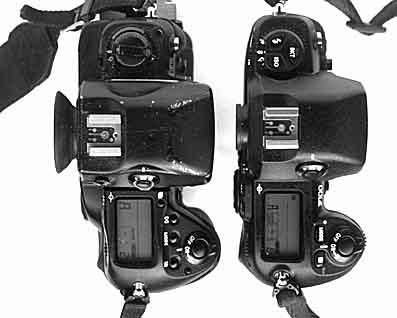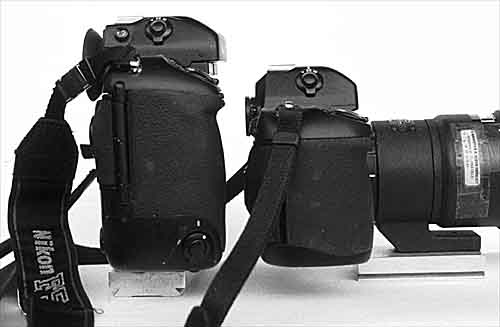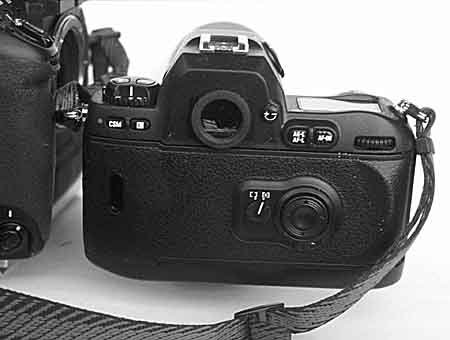Nikon
F100: First Hands-On Impressions of an F5 "Petite"
By Bjørn Rørslett
Here I was with the brand new Nikon F100
and it felt like welded into my hands. Handling it really was
instinctive for a seasoned F5 user and probably would be so to
most other people. The demo camera, the only one here in Oslo,
was in great demand and I could use it only for a short time.
However, I will have access to it again next week and then there
hopefully shall be time enough to run some really rough tests on
it (I did promise to bring it back to the dealer's, but did not
state its condition ..).
The F100 is a direct crossing between the
prestigious and quite expensive F5 and the its cheaper
predecessor, the F90 (designated N90 in the US). From its
external looks it's obvious that F5 was the dominant party of
that crossing. The advertising material produced for the F100
further underpins this impression by directly indicating a visual
transition from F5 to F100. So hey, you are assumed to get a Pro
camera here. Now let's go into details to see exactly what the
F100 offers.

F100 has a non-interchangeable viewfinder, lacks colour matrix
metering, has no mirror-lockup and is able to achieve less frames
per second that F5, but a framing rate of 4-5 fps should satisfy
most potential buyers. Only a rudimentary databack will be
available. Obviously F100 is targeted at photographers not
willing to spend a fortune on F5 but nevertheless wanting to make
use of the advanced features of that model. Thus F100 shares many
F5 features such as its flash wizardry, command wheels to operate
shutter speed and aperture jointly or independently, selectable
multi-spot areas, and the essential auto modes such as P
(Programmed mode with optional override), A (Aperture Priority),
S (Shutter Priority - equally useless in practice here as for
F5), and Manual mode. There isn't a trace of the brain-dead and
utterly useless "Programs" which infest F90. Good news
- back to basics.
The relationship to F5 is visually
strengthened by the F100's rubberised outer coating, which is
decorated with a red trim strip as in the F5. The body is made in
magnesium alloy and has an attractive hammered surface finish. It
makes a much more durable and solid impression than its cousin,
the F90. The viewfinder is very bright and clear, in fact
presenting a slightly clearer view of the subject than does F5,
and the indications in the viewfinder are very easy to read
indeed. This is helped by a red outline of the currently active
focus area of which there are five, and these can be selected by
a multiway oversized button in the rear. The nice thing here is
that there is a locking lever immediately below the focus area
selector making it a breeze to lock focus to any position.
Certainly a vast improvement over that of the F5! Basic
bracketing facilities are built-in and can be selected in 1/3 EV
steps.
Other details show clearly that Nikon has
learned from F5 and you'll find a number of minor improvements to
make handling the camera easy. Thus, the AF start button on the
rear is enlarged and has a rough surface to help it stand out
from the adjacent AE/AF lock. The AE lock now can operate as a
true lock in the sense that exposure can be locked into place
with a button press and will not change until the button is
pressed again. How I wish that feature could have existed on F5 -
we are not all of us having 3 arms to press and hold all those
option buttons ... The custom functions of F100 are controlled
largely similar to F5 and most control features of F5 are
repeated for this new camera. Those having acquired the
Photosecretary software and special PC-camera cables for F5 will
be pleased to learn that the program functions also for F100. At
least, the F100 brochure states so, but my Photosecretary didn't
recognise F100 when I hooked it into my NT computer. I have to
add that this F100 was a pre-series model and the problem
hopefully is fixed for production cameras.
The camera runs on 4 penlight-size
batteries. Data in the manual indicates that Lithium batteries
are to be preferred, and these are the only viable alternative at
low temperatures. There is a booster module (MB-15) with its own
shutter release for vertical shooting and this unit extends the
battery capacity to 6 AA cells; it can also run on the new MN-15
NiMh battery pack. However, Nicads and rechargeable NiMHs of 1.2
V capacity cannot be used.
The shutter release of F100 operates very
smoothly as customary for modern cameras. When the shutter is
tripped, the camera does make a more highly pitched sound than
the F5, no doubt because F100 weighs only 3/4 kg. Its AF action
was extremely fast and certainly did not yield to F5 - in fact,
my impression was that focusing the 20-35/2.8 AFD and 85/1.4 AFD
with F100 was even faster than on F5! Both cameras share the same
AF module with 5 high-level and 5 low-level light sensors to make
a total of 10 sensors, some of which are tilted to gain AF
precision. Thus the quick AF response of F100 could be due to
improved AF software. I recently tried the new AFS 80-200 f/2.8
Nikkor on F5 and that was a blindingly fast combination in AF
mode. Wonder what F100 can make this zoom do - hopefully I'll
manage to find this out in a short while.
Nikon claims the matrix metering for F100
is improved by giving it 10 sensor segments. Probably the
software evaluating the data is more important than the number of
matrix segments per se. From my cursory tests of F100 vs F5 I
could not detect any significant difference between them.
Prolonged field use next week will throw more light on this.
Meanwhile, it seems evident that Nikon had stored some clever
tricks up their sleeve. F100 is going to be a winner camera.
 |
To top of page |
More Details of F100:
Viewfinder Layout
F100 complies with contemporary
Nikons in having a high-eyepoint viewfinder, a feature which a
major competitor lack. Thus even people wearing glasses can
easily take in the entire view in the finder of F100, which shows
96 % of the film frame. Applying slight pressure on the shutter
release, or the rear AF button, turns on a bright red outline of
the currently active focus area. Beware though that this causes
approx. 1/3 stop exposure deviation so accordingly the light just
stays on for a fraction of a second. The groundglass of F100 is
very bright, in fact, clearly is superior to the standard EC-B
screen of the F5. Another advantage is a lack of moire pattern
for a DOF preview, and this holds for true macro photography as
well. The colour sensors of F5 impart disturbing moire and dark
spots on the standard F5 screen when the effective aperture of
the lens is small, say f/11 or less, to make that camera less
suitable - indeed hopeless - for work at high magnification.
The layout of the viewfinder of
F100 is far more discreet than on the F5. All information is on a
panel below the finder image. There are no brightly illuminated
areas outside the screen as on F5, and the only displayed colours
are green on grey. This unclutters the information display to a
large extent and most of the data thus are easy to read. However,
being smallish and monochrome the focusing indicators are
significantly less prominent on F100 than on F5, the latter
camera having conspicuous red and green focus markings in its
finder. Probably this would be of no concern to the dedicated AF
enthusiast but there are other people that do employ MF lenses on
any Nikon and F100 would be no exception to this. The MF lens
user however will find the F100's electronic focus-assisting
feature of little practical value unless the camera is mounted on
a tripod.
For some incomprehensible reason
F100 lacks the eye-piece shutter found on all earlier F-series
Nikons starting with the F2 model range. This in turn makes using
the camera on a tripod at an automatic mode setting awkward and
impractical. You definitely have to remember to cover the
eye-piece to avoid stray light influencing the exposure. Each to
his own but this feature wasn't wise to exclude! Of course, when
F100 is put into manual mode this problem doesn't exist.
 |
To top of page |
Practical Experiences with
Metering on the F100
A few days after my first encounter with
F100, I had a new opportunity to use the camera. This time I
aimed to elaborate on the technical merits of this newcomer from
Nikon. For example, how did F100 cope when you mount a non-AF
lens on it. Clearly you won't get AF in this case, but in order
to fully utilise the vast arsenal of older (and often superior)
MF Nikkors, F100 should be able to give precise metering even
when using a non-automatic lens, with stopped-down shooting or
with teleconverters. It's a fairly well known secret among Nikon
aficionados that F4 didn't exactly pass that test with flying
colours. F90 did better and F5 was nearly impeccable in this
respect, coming up to the standard of F2 AS.
I'm happy to report that F100 handled
nearly all metering challenges I did throw on it in an excellent
manner. Thus, stop-down metering through my 28 f/3.5 and 35 f/2.8
PC Nikkors gave identical readings to those of F5, and matched my
trustworthy F2 AS. My F4's were not up to this challenge at all.
Using old Micro-Nikkors with extension tubes to bring the
effective aperture below f/5.6 proved no obstacle to the F100
meter either in spot or centre-weighted mode. The only deviation
occurred for the Noct-Nikkor 58 mm f/1.2, a super-speed lens that
Nikon admit needs -1/3 to -1/2 stop correction on F5 to avoid
overexposure. Even taking this compensation in account, F100
indicated +1/3 stop error compared to my F5. I wouldn't call this
a significant problem, but those fortunate to own the otherwise
excellent Noct-Nikkor should be aware of this issue which
incidentally is covered in the F100 manual.


